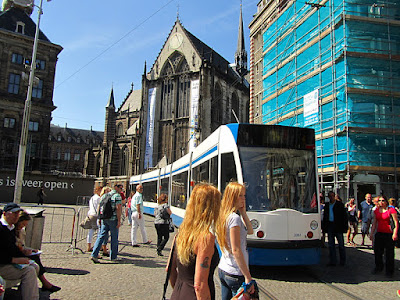The Netherlands have always been known for its outstanding road and waterworks system. From The Middle Ages on the Netherlands always had good point-to-point road systems (the diligence-system) and good waterways (trekvaarten; the canal-system that lead from city to city), that connected all the major cities. This system was further expanded when in 1839 the first railway was opened that ran from Amsterdam to Haarlem. In the next couple of decades this system expanded into a nationwide system. Every major city became connected on rails with other cities in The Netherlands. Since the train was a new phenomenon a complete new infrastructure had to be build to facilitate the transport over rails, but also to accommodate waiting passengers. Travelling by train was expensive and therefore trains were only used by the rich who could afford a (second) house outside of the major city where they worked. They were, in fact, the first commuters (Schmall, 2003). To facilitate this “commuting” and to make travelling easy, the new stations were often built just outside of the busy and historic downtowns, at the end of a major artery. Examples are Amsterdam Central station, The Hague central Station, Rotterdam Central Station, Utrecht Central Station & Leiden Central Station. But the old ways of living are changing: after the 1960’s a new trend arose in the spatial living preferences; People used to move to the big city and rail lines ran from downtown to downtown. This all changed after the economic growth of the 60’s and 70’s. The economic boom of that resulted into a fled of the city. New Towns and suburbs where booming. People no longer worked and lived in the same place; making travel patterns appear crisscross on the map. The result of this phenomenon was the biggest change in urban living forms we have seen so far; The Netherlands, and countries around the world, changed from a monocentric city landscape into a huge, diverse polycentric urban landscape. This phenomenon is greatly described by Castells (1989 & 1996) and others.
Since the urban landscape has changed radically the last 30 years, much of the old “polder1” sites have been claimed by the expanding cities and towns. This change resulted into a completely different pattern of travelling; instead of having the focus on a couple of central axis, travel patterns seem to emerge crisscross in the urban landscape.
Although new forms and places of living have emerged the last couple of decades, our infrastructure and especially the infrastructure of our public transportation system, have had significant problems adjusting to this new situation. Especially the so-called “hard infrastructure2” is still mainly focused on the situation as it was in the 60’s and 70’s; a system mainly focused on bringing commuters from the suburbs to the main city.
As said before, institutions had a hard time adjusting to this new situation. Everywhere where try to adjust to the new situation there is a hard collision between the (already) built environment and the realization of new public transportation.
Since the urban landscape has changed radically the last 30 years, much of the old “polder1” sites have been claimed by the expanding cities and towns. This change resulted into a completely different pattern of travelling; instead of having the focus on a couple of central axis, travel patterns seem to emerge crisscross in the urban landscape.
Although new forms and places of living have emerged the last couple of decades, our infrastructure and especially the infrastructure of our public transportation system, have had significant problems adjusting to this new situation. Especially the so-called “hard infrastructure2” is still mainly focused on the situation as it was in the 60’s and 70’s; a system mainly focused on bringing commuters from the suburbs to the main city.
As said before, institutions had a hard time adjusting to this new situation. Everywhere where try to adjust to the new situation there is a hard collision between the (already) built environment and the realization of new public transportation.
 |
| Tram in Amsterdam |
 |
| Tramway in Amsterdam |
more about public transport in Europe:
No comments:
Post a Comment